Albert M. (ed.) Biometrics - Unique and Diverse Applications in Nature, Science, and Technology
Подождите немного. Документ загружается.

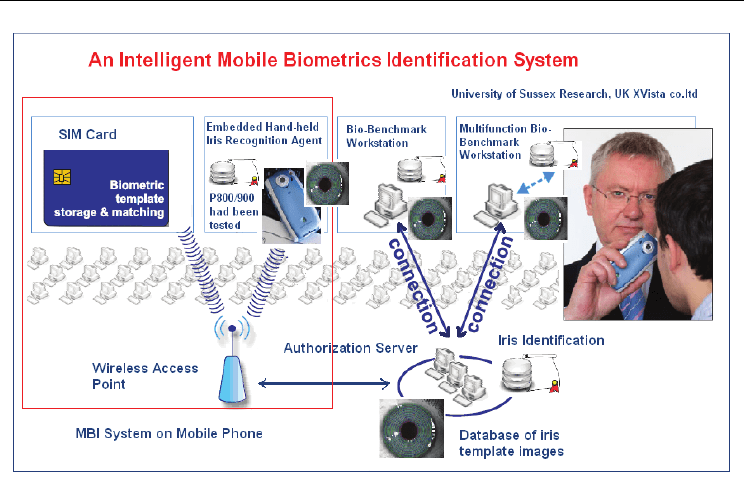
Iris Recognition on Low Computational Power Mobile Devices
111
Fig. 2. Component and Functional Design of the MBI System
The third kind of medium is the database of a benchmark workstation. Comparatively, this
method is specially designed to allow enterprise users access to a large-scale iris template
database to authenticate iris images. However, this medium is currently not psychologically
acceptable to some users.
As introduced in the abstract, the MBI system can collaborate seamlessly with other
applications on mobile phones. In our work, we combined the MBI system with a mobile
two-dimensional barcode reader as a biometrics mobile payment (BMP) system. The aim of
the BMP system is to provide a secure means for authorizing users therefore preventing
payment risks for both user (customer) and acquirer (financial institutions). The BMP
system consists of two main parts: a two dimensional barcode reader and a MBI system.
Users firstly need to use the barcode reader to scan the barcodes of products or bills that
they would like to purchase or pay. There are two means of getting information on
products: locally from the database of the mobile phone or by logging into a server station.
The local database in the mobile phone can provide personal preference information of the
user, such as the list of favorite products and the account information of frequently scanned
bills. This approach allows users to keep their iris information private. However it is not
possible to save the entire history of what a user has been purchasing in a mobile phone
database, due to the memory limitation on mobile phones. There is no such limitation when
getting product information via the network; however, the network speed can be
constrained, hence the purchase procedure may require more time.
Once the product information has been received, a user can decide whether or not to
purchase the goods. If a user gives a confirmation for purchase, the MBI system will
automatically start up and provide an authorization process to establish the user’s identity.
There are two ways to get a user authorized. The first way is to recognize the user’s iris

Biometrics - Unique and Diverse Applications in Nature, Science, and Technology
112
using the template images stored in a local database, for example on a mobile phone or
PDA. By using this means, a user can send confirmation of a specific certificate of
authorization that is generated on the mobile phone to a financial institution through the
wireless network. Once a financial institution receives this certificate, they will decode the
certificate and confirm the payment with both the merchant and the user; this confirms the
user’s identity and authorizes the payment. The second method is to send the iris code to
the financial institution for transaction authorization; this method can help the financial
institution reduce the risk of accepting fake certificates; however this method is currently
not psychologically accepted by some users.
Once a payment confirmation is given to both a user (customer) and a merchant, the
purchase by mobile phone is completed.
After explaining the working procedure and system design of the MBI and BMP system, the
next section illustrates its agent oriented software architecture.
When designing the architecture of the MBI system, technologies such as distributed agent
and multi-agent systems were employed. These technologies are the complementary
approaches to the object paradigm and provide a means of designing and implementing
complex distributed software (Garcia etc., 2004). Agent technologies (Chen etc., 2006)
represent the most important new paradigm for software development (Luck, 2004), and
have already been used in a diverse range of applications in manufacturing (Shen etc., 1998;
Wada etc.,2002; Van Dyke Parunak etc., 2001), process control system, electronic commerce
(Sandholm, 2002), network management, transportation systems (Chen, 2002), information
management (Stathis etc.,2002), scientific computing (Boloni etc., 2000), health care (Huang
etc., 1995) and entertainment (Noda and Stone 2003). The MBI system applies a combination
of agent technologies, e.g. scientific computing, network management and information
management.
By using these agent technologies, seven distributed agents are generated: image acquisition
agent, data matrix decoding agent, iris image processing agent, iris image identification
agent, wireless network agent, database management agent and communication agent. The
organisational networks in the MBI system and the BMP system are shown in Figure 4 and
Figure 5.
Image Acquiring Agent: This agent acquires images from live video inputs via cameras
integrated into mobile phones to capture data matrix images or iris images.
Data Matrix Decoding Agent: With an image acquired using the image acquiring agent, the
data matrix decoding agent will implement our algorithm to provide the decoded result of
the data matrix.
Iris Image Processing Agent: With an eye image acquired using the image acquiring agent,
the iris image processing agent can find the inner and outer boundaries and extract the iris
information into an iris code.
Iris Image Identification Agent: The iris image identification agent compares an iris code
generated by the iris image processing agent with template arrays stored in a local database
using the Hamming Distance. If the similarity level between the user iris code and the best
matched template code is higher than a threshold, the user iris code is considered to be
correctly identified; otherwise a message ‘no match’ is displayed.
Database Management Agent: This agent is used to manage the local database of the MBI
system. Its functionality includes register, update, check and remove user’s personal iris
code or other relevant information such as a person’s name, address, banking details, etc.
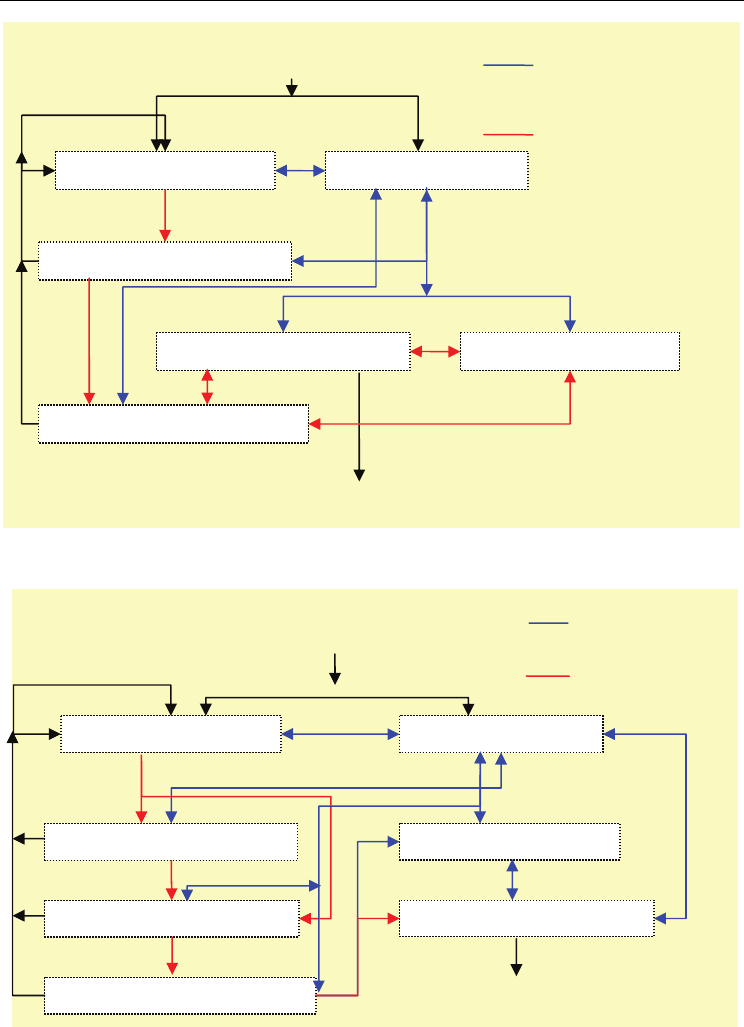
Iris Recognition on Low Computational Power Mobile Devices
113
Fig. 4. Distributed Agents and Agents’ Organisational Network in MBI System
Fig. 5. Distributed Agents and Agents’ Organisational Network in BMP System
Start
Organisational
Network
Work routines
among agents
End
Fail
Image Acquiring Agent Communication Agent
Iris Image Processing Agent
Wireless Network Agent
Database Management Agent
Iris Image Identification Agent
Data Matrix Decoding Agent
End
Fail
Start
Image Acquiring Agent Communication Agent
Iris Image Processing Agent
Wireless Network Agent Database Management Agent
Iris Image Identification Agent
Benchmark Workstation Mobile phone
Organisational
Network
Work routines among
agents
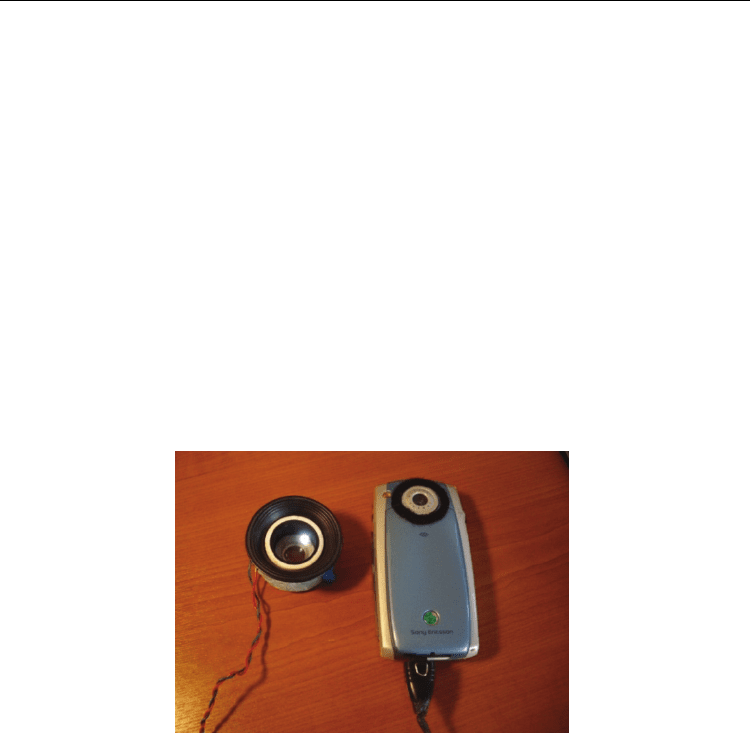
Biometrics - Unique and Diverse Applications in Nature, Science, and Technology
114
Wireless Network Agent: This agent is used to transfer information between mobile phones
and wireless network servers (also used for the benchmark workstation). Currently this
agent can only enable the information transformation between mobile phones and network
servers having fixed IP addresses due to security considerations. All internet information
required by users needs to be downloaded by a server station and then filtered and
redirected to the mobile users. This arrangement enhances the security of the MBI system.
Communication Agent: There is no core agent in the network. All communication such as
requirements or negotiations should be sent via the communication agent. The
communication agent creates links between the six other distributed agents and orchestrates
all the actions required for both the data matrix decoding and iris image recognition.
4.2 Optics design
An assumption is made in developing the iris image processing that every eye image is
taken from an environment with the same illumination and with the same distance between
eye and camera. With this precondition, it is possible to set up parameters, such as
boundary searching areas, and test the performance of the image processing algorithm. To
achieve the same illumination, an ‘eye cup’ was produced with a luminous diode attached,
as shown in the picture below:
Fig. 6. An ‘Eye Cup’ with a Luminous Diode links to the Sony Ericsson P800 Mobile Phone
This standardized illumination environment plays a crucial role in the design of the image
processing algorithms. Several optical experiments were performed to test the ‘eye cup’ to
ensure that the live video inputs taken with this ‘eye cup’ always focuses on the iris area.
4.3 Iris recognition algorithm
The procedure for iris image processing, designed to be run on mobile phones, follows the
steps: loading an input image of eye, iris image localization and extraction of the iris
characteristics into an iris code(patent no: GB0703399.6-PCT/GB2007/000591). This
procedure is shown in Figure 7.
For the same illumination the same eye will give the same pupil response, hence, the
relationship between the radius of the pupil and the radius of the outer iris boundary will
not change, The variability due to the illumination response of the pupil is removed during
iris localization, by using the ‘eye cup’.
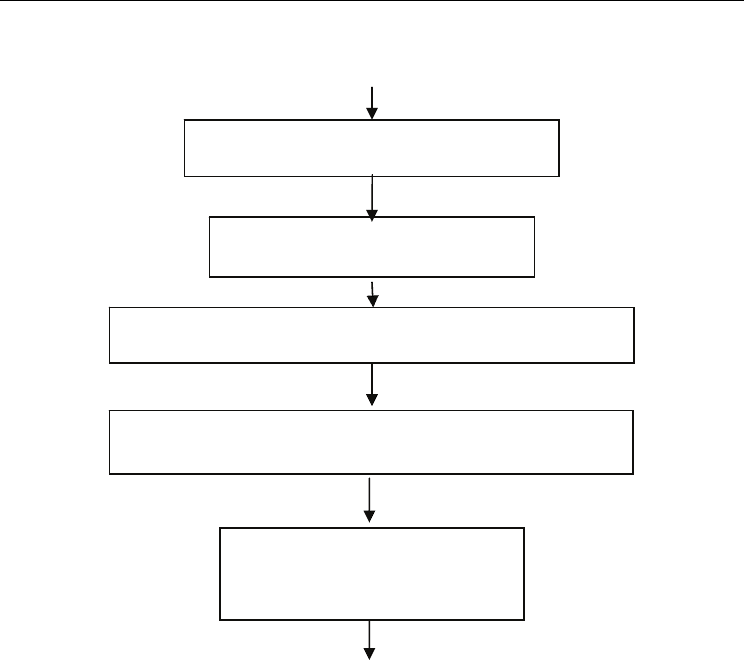
Iris Recognition on Low Computational Power Mobile Devices
115
Fig. 7. The Procedures of Iris Image Processing
There are two sub-steps during the iris image localizations. Firstly, histogram analysis is
applied for finding the average pixel values of the pupil area, iris area and sclera area from
the input image, as well as the minimum pixel value and maximum pixel value of the iris
area. Secondly, the inner and outer iris boundaries are found using the pixel-oriented
method with the association of the different average pixel values and maximum/minimum
values that are found from the histogram analysis. Figure 8 shows the calculated pupil
boundary.
In these steps, failure is allowed in each step. Once a failure occurs, the iris image processing
agent will communicate with the image acquiring agent via a communication agent to
acquire a new image. There is a setting for the ‘maximum number of images’ in the MBI
system, the communication agent monitors if the number of failures reaches this pre-set
threshold. If this threshold is reached, a ‘fail’ notice for iris image decoding will appear on
the main panel GUI of the MBI system. For more details of the iris recognition algorithms,
please refer to (Lu, 2008).
Locate iris bands and store pixel values
Finding the inner and outer iris boundaries
Iris code (Vector array)
generation
Loading an input image
Histogram analyses
Start
End
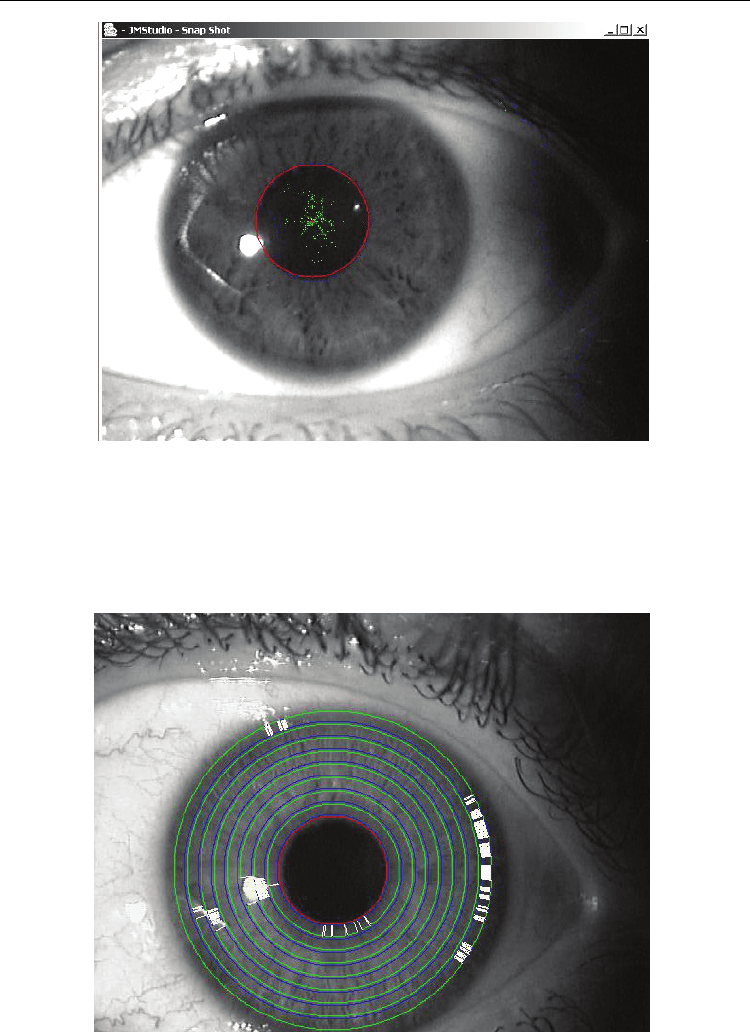
Biometrics - Unique and Diverse Applications in Nature, Science, and Technology
116
Fig. 8. Pupil Centre and Pupil Boundary
The area between the inner and outer iris boundaries is the iris area. There are also two sub-
steps in generating an iris code. First, a number of (in this algorithm the number is eight) iris
bands will be located on the iris area. Second, a radial averaging filter is applied to transform
the band-data into a one dimensional signal, as shown in Figure 9. For the cases of eight iris
bands located on the iris area, eight one dimensional signals will be generated after filtering.
Fig. 9. An Example of the 8-Circle Iris Bands
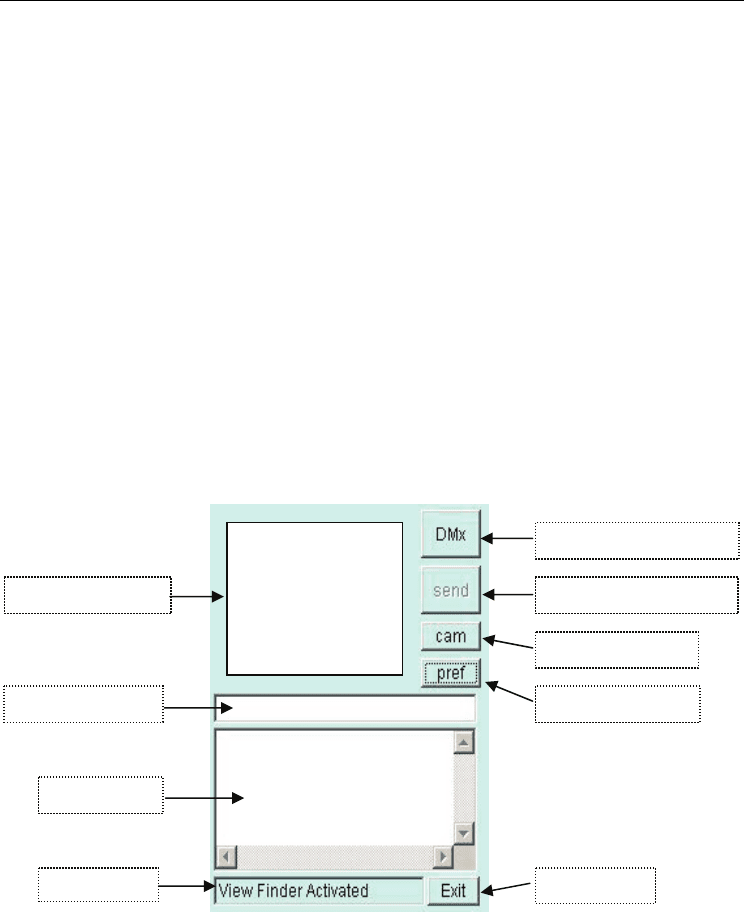
Iris Recognition on Low Computational Power Mobile Devices
117
5. Implementation
Based on the notion that many of the latest mobile phones are running on the Symbian
operating system and using Java or the C++ programming language for programming
developments, the biometric mobile payment system is developed for mobile phones
running Symbian OS using Java 2 Micro Edition (J2ME) with Mobile Information Device Profile
(MIDP). By using J2ME, the iris identification program is compatible with benchmark
workstations with the benefits of the platform independency of Java codes.
All programming developments indicated in this paper have had been tested on a Sony
Ericsson P800 mobile phone. It was the most advanced Symbian OS mobile phone at the
time this project was started, supporting personal Java and MIDP 2.0 and equipped with a
VGA sized camera. The Sony Ericsson P800 is embedded with an ARM 9 processor running
at 156MHz. This processor power must be shared among common mobile phone functions.
In the following section, the design of the GUIs and their functions are described in detail.
Moreover, how distributed agents are launched via the GUIs and how these agents
communicate with each other is also outlined.
The different GUIs are described in a sequence following the working procedures of the
BMP system. There are two main graphical user interfaces (GUIs) and six preference menu
GUIs that were developed using Symbian UIQ. After starting the BMP system, the main
panel of the mobile two-dimensional barcode reader is the first interface to be displayed, as
shown in Figure 10 and Figure 11.
Fig. 10. Main panel of Mobile Two-Dimensional Barcode Reader
This main panel consists of three display windows and five command buttons. To use this
barcode reader, users must position the mobile phone at a distance from the symbol so that
the image formed on the mobile phone’s View finder area is in focus and approximately
centred and straight. The View finder area window is managed by the image acquiring
Network command
Camera Refresh
Exit Button
Preference Menu
View Finder area
Live Output
Decoding Result
Data Matrix Decoding
Status Ba
r
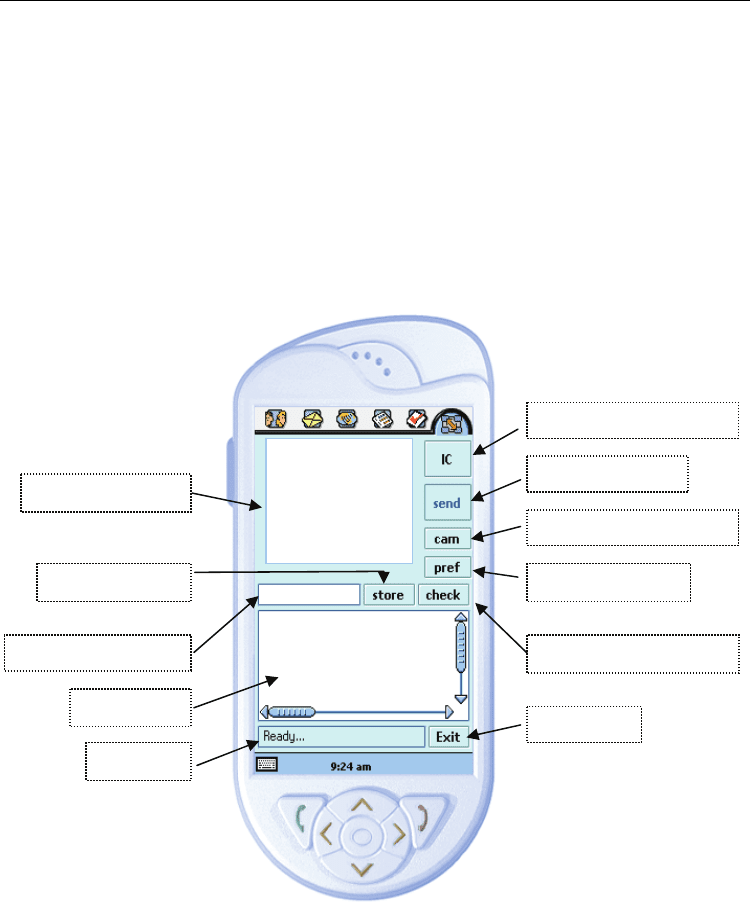
Biometrics - Unique and Diverse Applications in Nature, Science, and Technology
118
agent and the barcode image processing agent for displaying a data matrix image taken by
the camera on the mobile phone. After pressing the DMx button, the image acquiring agent
will start the image acquisition and send an image to the data matrix decoding agent. The
view finder area will be switched off during processing to optimize the available CPU power.
When the code has been successfully decoded, information related to the barcode, such as
price, amounts of product left, will be displayed in real-time in the Live Output Window. By
using the check button (as shown in Figure 14(a)), users can access the local database to get
information that relates to the barcode last scanned. The send Button is used to send the
contents in the decoding result window to the server. This button is designed for the mobile
commerce purposes and not to be used without a connection to a wireless network.
According to the tests on the Sony Ericsson P800 mobile phone, an average decoding time,
using a standard VGA size image, is 60ms to 100ms.
Fig. 11. Main Panel for the Mobile Biometrics Identification System
After users confirm purchase, a GUI for mobile biometrics identification will appear, as
shown in Figure 10. There are four display windows and seven command buttons in this
Panel. The Live Video Input Window is monitored by the communication agent and managed
by the image acquiring agent and the iris image processing agent when displaying the live
video input from the camera or displaying an iris image with its iris boundaries located (ie,
Network Button
Camera Refresh Button
Exit Button
Preference Menu
Live Video Input
Live Output
Identification Result
‘Iris Code’ Acquisition
Status bar
Register Button
Identification Command

Iris Recognition on Low Computational Power Mobile Devices
119
when the iris image processing succeeds). The Identification Result Window is managed by the
iris image identification agent and used to display an identification result in a single line. It
is also used to name a new iris code with a registration procedure. The Live Output Window
works as a real time messenger interface to display live messages received from each agent.
The messages include the status of image processing progress (success or failure), the full
list of iris comparison results and the iris code generation time, etc. The IC Button, short for
‘Iris Code’, is used to activate the image processing agent to achieve a valid iris code. After
the IC button is pressed, the live video input window will be temporally closed to save
computational power. It will be reopened after the iris image processing agent has produced
an output, which is either a valid iris code or a notice of failure. When an iris code is
successfully generated, the pupil boundary and the iris bands are shown on the iris image.
Therefore users can manually decide whether the iris image processing agent produced a
correct pupil boundary or not. If a user does not agree with the localization of a pupil
boundary, s/he needs to press the ‘cam button’ on the main panel and press the IC button
again to restart the image processing procedures. Alternatively, if a user agrees with the
localization, the iris code can be compared with iris templates in a database for iris
identification (by pressing the ‘Check button’) or be registered to a database as a template (by
pressing the ‘Store button’). Different from the two dimensional barcode reader, the Send
button in the MBI system is a network button used to activate the wireless network agent
and send the iris code generated most recently to a server station for registration or removal
purposes (the IP address and the Port number of the benchmark workstation are set in the
Network Preference Menu). After pressing the check button, the last calculated iris code will be
compared with the template codes stored in the database of a benchmark workstation or the
mobile phone. This button is only activated after a ‘success’ notice is received from the
image processing agent and the communication agent. The identification result will be
displayed in the Identification Result window. The matching rate that is the total number of
pixels matching the iris code’s template pixels will be displayed on the Live Output
window. The store button is used to store the iris code that successfully decoded most
recently into a database, either located in the benchmark workstation or in the mobile
phone. In order to register an iris code, a name must be typed in the identification result
window. This name needs to be less than 20 characters and have a different name from
other data that has been stored in the database. Any preceding or trailing spaces in this
name will be removed automatically by the database management agent during
registration. Associated with the panels of the two dimensional barcode reader and MBI
system, there are in total six preference menus which can be set by users. These menus can
be accessed by pressing the pref button on the main panel.
As shown in Figure 12(a), this menu provides the facilities for setting the image colour,
image size and the maximum number of images that can be acquired during a biometrics
identification process and the minimum matching rate (details are given in the latter part of
this section). The image setting menu for barcode reading, as shown in Figure 12 (b) enables
contrast and luminosity tuning which is required for barcode reading different coloured
data matrix.
Figure 13 (a) illustrates the GUI for the database options. This GUI can help a user review or
remove information, such as iris information and product information, on the local database
on a mobile phone. Figure 13 (b) illustrates the GUI of the log monitor, as indicated by its
name, this GUI is designed to help users monitor all the attempts and the history of attempts
for accessing information from the BMP system on a mobile phone.
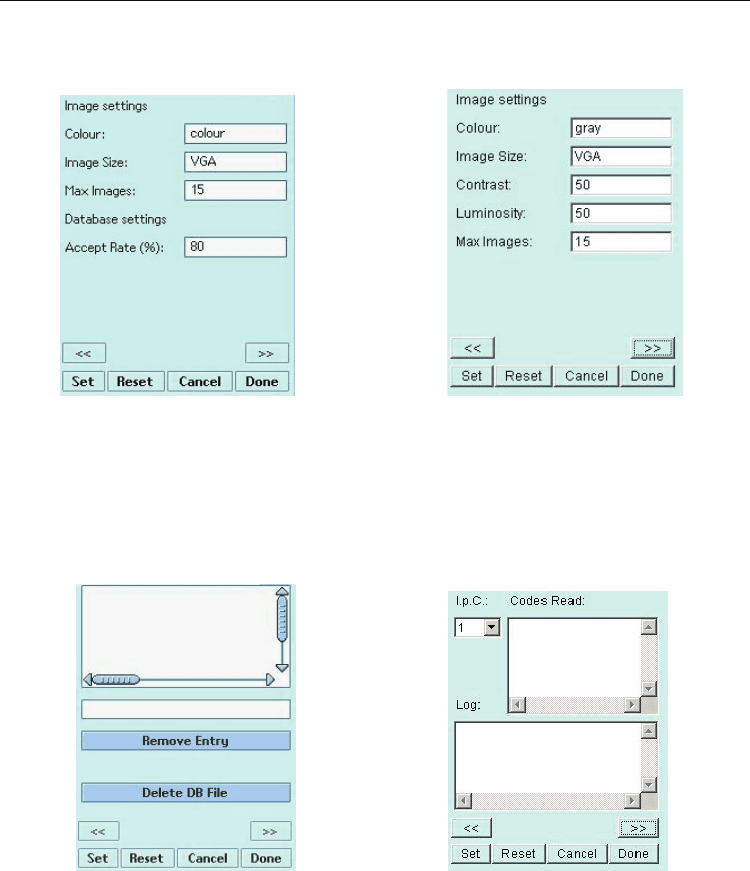
Biometrics - Unique and Diverse Applications in Nature, Science, and Technology
120
(a) (b)
Fig. 12. Image Setting Menus of BMP System: (a) image setting and accept rate setting menu
for biometrics identification; (b) image setting menu for barcode reading.
(a) (b)
Fig. 13. Graphical User Interfaces: (a) Database Options (b) Log Monitor
The GUIs shown in Figure 14 (a) and (b) illustrate the network menu and the tool options.
These two GUIs help mobile phone users transmit product information and iris codes
between server stations and mobile phones.
